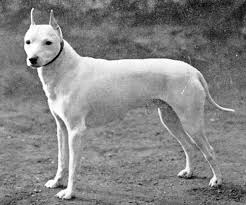
English White Terrier
Conditions of detention
The English White Terrier was well-suited to indoor living due to its small size and companionable nature. They thrived in homes where they could be close to their owners and participate in family activities.
Useful Fact: They were not suited to harsh outdoor conditions and required a comfortable indoor environment.
Nutrition and diet
A balanced diet of high-quality dog food appropriate for their age, size, and activity level would have been essential to maintain their health.
Useful Fact: Due to their propensity for health issues, a well-monitored diet with appropriate portion control would have been crucial.
Health
The English White Terrier was prone to several genetic conditions, including deafness and various structural health problems. Regular veterinary care would have been necessary to manage these health issues.
Useful Fact: Breeding practices at the time did not emphasize health, which contributed to the breed’s eventual decline.
Grooming and care
The English White Terrier had a short, smooth coat that required minimal grooming. Regular brushing would have kept their coat in good condition.
Useful Fact: Their grooming needs were relatively simple compared to long-haired breeds, making them low-maintenance in terms of coat care.
Education and training
They were intelligent and eager to please, making them relatively easy to train with positive reinforcement methods. Consistent and gentle training from an early age would have been essential.
Useful Fact: Early socialization and obedience training would have helped them develop into well-mannered companions.
Toys and entertainment
Interactive toys and activities that challenged their mind and body would have been ideal. They enjoyed playing fetch and other games that allowed them to use their intelligence.
Useful Fact: Providing a variety of toys and activities could have helped prevent boredom and kept them mentally stimulated.
Safety
A secure and safe environment, especially when they were outdoors, would have been crucial. Their small size and delicate health made them vulnerable.
Useful Fact: Supervision during outdoor activities and using a leash would have been important for their safety.
Accessories
Durable leashes, collars, and harnesses, along with comfortable bedding, would have been necessary. Grooming tools like brushes and nail clippers would have been essential.
Useful Fact: Using a harness could have provided better control during walks and reduced strain on their neck.
Socialization
Early and ongoing socialization with different people, animals, and environments would have been vital to prevent shyness and ensure they were well-adjusted.
Useful Fact: Regular interactions with other dogs and exposure to various settings could have helped them develop into confident and friendly pets.
Travel and Transportation
They would have adapted well to travel, needing secure crates or harnesses for safety during car trips. Their small size made them easy to transport.
Useful Fact: Frequent breaks during travel could have helped them manage stress and remain comfortable.
Behavior and psychology
English White Terriers were known for their lively, intelligent, and affectionate nature. They formed strong bonds with their families and enjoyed being active and social.
Useful Fact: Understanding their need for companionship and engagement could have helped manage their behavior effectively.
Legal aspects
Owning an English White Terrier would have involved adhering to local pet regulations, including leash laws and registration requirements.
Useful Fact: Familiarizing oneself with local laws and regulations could have prevented legal issues and ensured responsible ownership.


